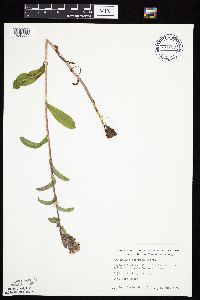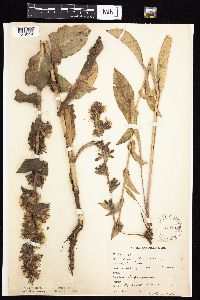Nabalus racemosus
|
|
|
|
Family: Asteraceae
Purple Rattlesnake-Root, more...purple rattlesnakeroot, glaucous rattlesnakeroot, glaucous white lettuce
[Prenanthes racemosa Michx., morePrenanthes racemosa f. rollandii Vict. & J. Rousseau, Prenanthes racemosa subsp. multiflora Cronquist, Prenanthes racemosa subsp. racemosa Michx., Prenanthes racemosa var. multiflora (Cronquist) Dorn, Prenanthes racemosa var. pinnatifida A. Gray, Prenanthes racemosa var. racemosa Michx.] |
Plants 30-175 cm; taproots fusiform, tuberous. Stems erect, green or light purple, simple, (stout), glabrous and glaucous proximally, setose or hispid distally. Leaves: proximal usually present at flowering; petioles broadly winged, (1-15 cm); blades broadly oblanceolate to spatulate, 4-25 × 1-8 cm, coriaceous, bases attenuate, clasping, margins entire or weakly denticulate, apices obtuse or rounded, faces glabrous; mid cauline sessile, clasping; distal sessile and reduced. Heads (ascending) in (elongate) narrowly racemiform or paniculiform arrays. Involucres campanulate, 11-12 × 4-7 mm. Calyculi of 8, dark green to purple, narrowly triangular-subulate bractlets 2-4 mm, coarsely setose. Phyllaries 7-14, green to purple, lanceolate to linear, 10-12 mm, margins scarious, sparsely to densely setose. Florets 9-29; corollas usually pinkish, sometimes white or lavender, 7-13 mm. Cypselae golden brown, sub-cylindric, subterete, 5-6 mm, indistinctly 8-12-ribbed; pappi pale yellow, 6-7 mm. 2n = 16. Flowering Aug-Sep. Sandy alluvial soils of stream banks, wet meadows, tall-grass prairies, fens, marshy flats, bogs (mainly calcicolous, at least in north); 0-2800 m; Alta., B.C., Man., N.B., Nfld. and Labr. (Nfld.), N.S., Ont., Que., Sask.; Colo., Ill., Ind., Iowa, Ky., Maine, Mich., Minn., Mo., Mont., Nebr., N.J., N.Y., N.Dak., Ohio, Pa., S.Dak., Vt., Wash., Wis., Wyo. Prenanthes racemosa is recognized by its erect, stout, simple habit, glaucous stems, spatulate proximal leaves with broadly winged petioles and rounded to obtuse apices, heads borne in narrow racemiform arrays, purple and hairy phyllaries, and usually pinkish corollas. It is most similar to P. aspera, which differs in its generally smaller stature, more hirsute stems, leaves that are hispid abaxially, proximal leaves usually withered by flowering, and creamy white or yellow corollas. Hybrids between P. racemosa and P. trifoliolata, known as P. ×mainensis, occur in the northeastern United States and southeastern Canada (see discussion under P. trifoliolata).
Plants 3-17 dm, long-hairy in the infl, otherwise glabrous and glaucous; lowest lvs petiolate, broadly oblanceolate to obovate or elliptic, the blade and petiole 7-40 נ1.5-10 cm, generally persistent; cauline lvs ±reduced upwards, becoming sessile and clasping; infl narrow and elongate, thyrsoid, the heads rather loosely ascending or occasionally nodding, with pink or purplish (white) fls; invol 9-14 mm, purplish or blackish, sparsely to usually rather densely long-hirsute; 2n=16. Streambanks, moist meadows, and prairies; Que. to N.J., w. to Alta. and Colo. Aug., Sep. Var. racemosa, with ca 8(7-10) invol bracts and ca 13(9-16) fls per head, occurs from Que. to N.J., w. to Minn. and Io. Var. multiflora (Cronquist) Cronquist, with ca 13(10-14) invol bracts and ca 21(17-26) fls per head, occurs from Alta. and Colo. to Minn. and Io., and occasionally through the n. part of our range to Que. and n. Me. Gleason, Henry A. & Cronquist, Arthur J. 1991. Manual of vascular plants of northeastern United States and adjacent Canada. lxxv + 910 pp. ©The New York Botanical Garden. All rights reserved. Used by permission. From Flora of Indiana (1940) by Charles C. Deam All of my specimens of this species are from the northern part of the state where it is infrequent and found in marshes and moist prairie habitats. …… Indiana Coefficient of Conservatism: C = 10 Wetland Indicator Status: FACW |
































































































